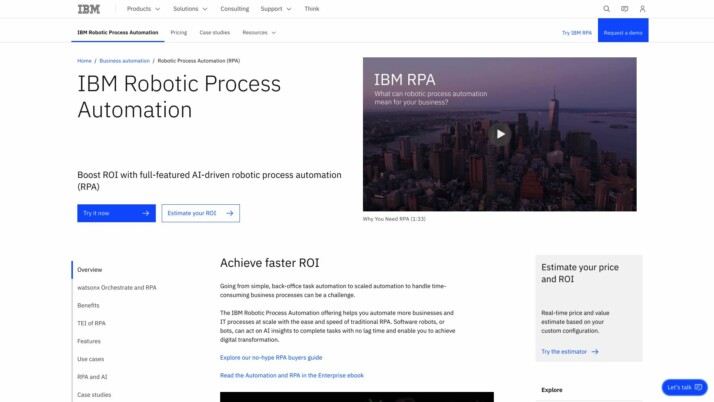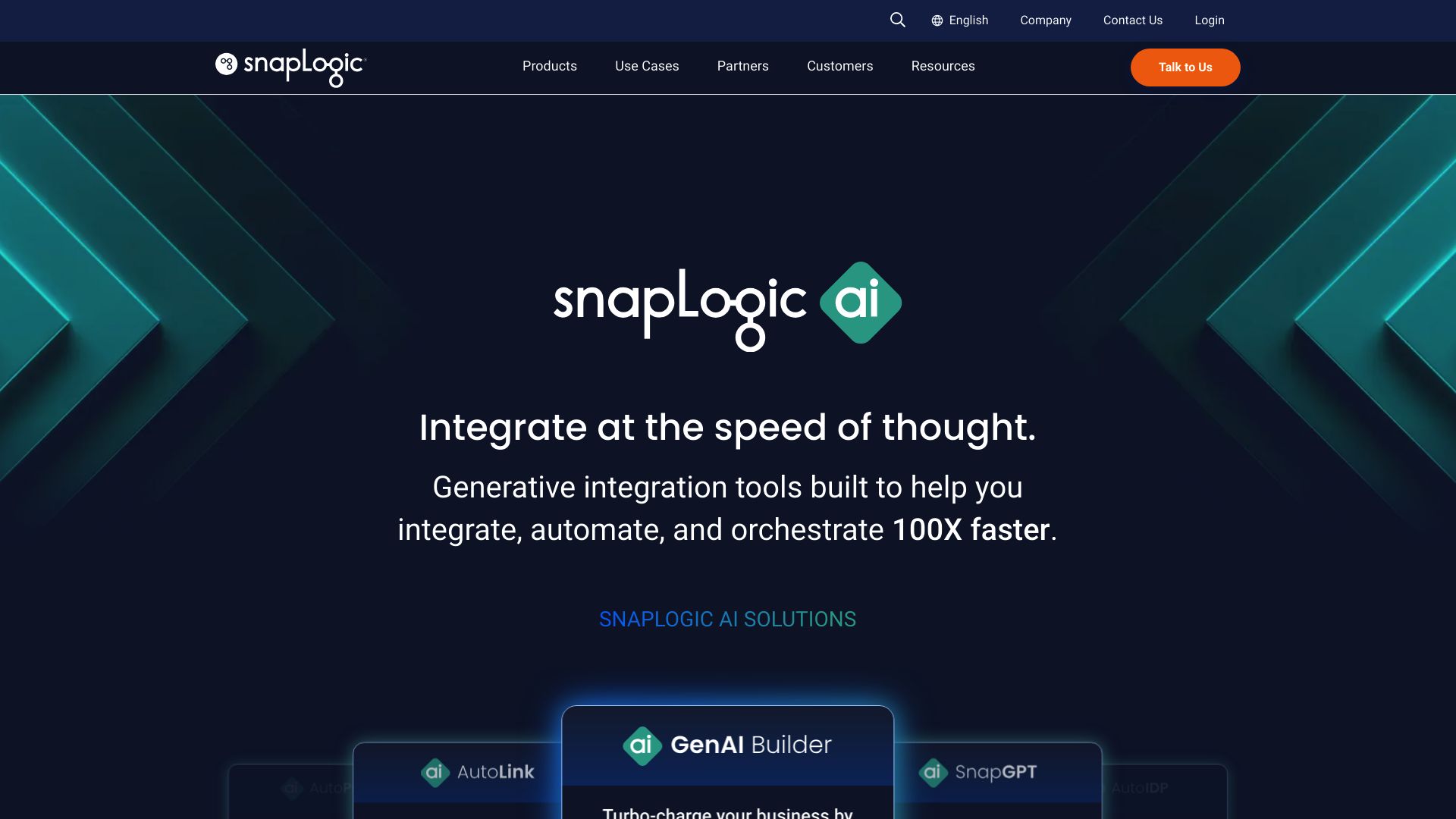IBM RPA vs. snapLogic AI: Comparing Enterprise Automation Solutions
AI-powered automation revolutionizes business operations, streamlining processes and boosting productivity. Our comparison of IBM RPA vs. snapLogic AI, and SmythOS reveals key differences in capabilities, ease of use, and scalability. IBM RPA excels in legacy system automation, while snapLogic AI offers intelligent data pipeline creation.
SmythOS, however, emerges as the superior choice, combining intuitive design with unmatched flexibility. This review equips decision-makers, developers, and business users with essential insights to select the ideal AI automation platform for their unique needs, emphasizing each solution’s strengths and potential impact on organizational efficiency.
IBM RPA Overview
IBM RPA transforms business operations through intelligent automation. This robust platform empowers organizations to create, deploy, and manage software bots that streamline repetitive tasks across various applications and systems.


IBM RPA combines low-code development tools with AI-powered capabilities, enabling both technical and non-technical users to build effective automation solutions. The platform’s visual builder facilitates rapid bot creation, while its AI integration with watsonx Orchestrate enhances decision-making and process intelligence.
IBM RPA combines low-code development tools with AI-powered capabilities, enabling both technical and non-technical users to build effective automation solutions.
Key features of IBM RPA include unattended and attended bots, allowing for both fully autonomous operations and human-in-the-loop scenarios. The platform supports multi-bot collaboration, enabling complex workflow automation across diverse enterprise systems. IBM RPA’s strong focus on governance and compliance, integrated with IBM OpenPages, ensures transparency and auditability in automated processes.
While IBM RPA offers extensive capabilities, its enterprise focus may present a steeper learning curve for smaller organizations or individual users. The platform’s strength lies in its scalability and integration with existing IBM ecosystem products, which may limit flexibility for users seeking standalone solutions.
IBM RPA positions itself as a comprehensive enterprise automation solution, competing with other major players in the RPA space. Its integration capabilities with legacy systems and mainframes set it apart, making it particularly attractive for large organizations with complex IT infrastructures. However, this enterprise focus may result in higher costs and implementation complexity compared to more lightweight alternatives.
snapLogic AI Overview
SnapLogic AI delivers an Intelligent Integration Platform (IIP) that harnesses AI-powered workflows to streamline the entire lifecycle of IT integration projects. The platform caters to both expert developers and citizen integrators, enabling them to design, develop, deploy, and maintain integrations across on-premises, cloud, and hybrid environments.
snapLogic AI stands out with its AI-powered integration capabilities, particularly its Iris AI technology. This feature provides intelligent recommendations for building data pipelines, significantly reducing the time and effort required for IT projects. The platform’s self-service interface, built with HTML5, offers an intuitive experience for users ranging from business analysts to IT professionals.
SnapLogic AI delivers an Intelligent Integration Platform (IIP) that harnesses AI-powered workflows to streamline the entire lifecycle of IT integration projects.


A key strength of snapLogic AI lies in its comprehensive integration support. The platform handles a wide array of data types and sources, including structured and unstructured data, as well as batch, real-time, and streaming data. It employs “Snaps” — integration connectors that seamlessly link SaaS and on-premises applications with various data sources. This versatility makes snapLogic AI suitable for diverse enterprise needs.
The platform handles a wide array of data types and sources, including structured and unstructured data, as well as batch, real-time, and streaming data.
The platform’s scalability and flexibility are noteworthy. By leveraging Amazon’s Elastic Compute Cloud (EC2) infrastructure, snapLogic AI can scale integration processes according to enterprise requirements, whether in the cloud or on-premises. This elastic integration approach optimizes computing power consumption and data proximity, addressing the needs of growing businesses.
Recent additions to snapLogic AI’s offerings include SnapGPT and GenAI Builder. These tools bring generative AI capabilities to the platform, enabling no-code development of AI applications. Employees can now create AI models and chatbots using natural language prompts, further democratizing AI development within organizations.
While snapLogic AI offers a robust set of features, potential users should consider their specific integration needs and technical expertise when evaluating the platform. The learning curve associated with fully leveraging its capabilities may be steeper for some organizations, particularly those new to advanced integration tools. Additionally, pricing information is not readily available on their website, which may require potential customers to engage with sales representatives for detailed cost structures.
Feature Comparison
IBM RPA and snapLogic AI offer distinct approaches to enterprise automation and integration. IBM RPA focuses on robotic process automation, using software bots to automate repetitive tasks across various applications. In contrast, snapLogic AI provides an Intelligent Integration Platform that leverages AI to streamline data and application integration processes.
IBM RPA excels in automating legacy system interactions, particularly in mainframe environments — a capability not prominently featured in snapLogic AI’s offerings. This makes IBM RPA particularly attractive for large enterprises with complex, established IT infrastructures. However, snapLogic AI’s Iris AI technology offers intelligent recommendations for building data pipelines, potentially reducing integration project timelines more effectively than IBM RPA’s approach.
In terms of security, both platforms prioritize data protection, but their implementations differ. IBM RPA integrates with IBM OpenPages for comprehensive governance and compliance tracking, a feature not explicitly mentioned in snapLogic AI’s capabilities. Conversely, snapLogic AI’s elastic integration approach, leveraging Amazon EC2, may provide more flexible scaling options compared to IBM RPA’s infrastructure.
Feature Comparison Table
| IBM RPA | snapLogic AI | SmythOS | |
|---|---|---|---|
| CORE FEATURES | |||
| AI Agents | ❌ | ✅ | ✅ |
| Memory & Context | ❌ | ❌ | ✅ |
| Autonomous Agents | ❌ | ✅ | ✅ |
| Explainability & Transparency | ❌ | ✅ | ✅ |
| Multimodal | ❌ | ✅ | ✅ |
| Problem-Solving Capabilities | ❌ | ✅ | ✅ |
| Multi-Agent Collaboration | ❌ | ✅ | ✅ |
| Work as Team | ❌ | ✅ | ✅ |
| SECURITY | |||
| Constrained Alignment | ❌ | ✅ | ✅ |
| OAuth | ❌ | ✅ | ✅ |
| IP Control | ❌ | ✅ | ✅ |
| COMPONENTS | |||
| Foundation AIs | ❌ | ❌ | ✅ |
| Huggingface AIs | ❌ | ❌ | ✅ |
| Zapier APIs | ❌ | ❌ | ✅ |
| Classifiers | ❌ | ❌ | ✅ |
| Data Lakes | ❌ | ✅ | ✅ |
| DEPLOYMENT OPTIONS (EMBODIMENTS) | |||
| Deploy as Webhook | ❌ | ✅ | ✅ |
| Staging Domains | ❌ | ❌ | ✅ |
| Production Domains | ❌ | ❌ | ✅ |
| API Authentication (OAuth + Key) | ❌ | ✅ | ✅ |
| Deploy as Site Chat | ❌ | ❌ | ✅ |
| Deploy as GPT | ❌ | ❌ | ✅ |
| DATA LAKE SUPPORT | |||
| Hosted Vector Database | ❌ | ❌ | ✅ |
| Sitemap Crawler | ❌ | ❌ | ✅ |
| YouTube Transcript Crawler | ❌ | ❌ | ✅ |
| URL Crawler | ❌ | ❌ | ✅ |
Best Alternative to IBM RPA and snapLogic AI
SmythOS redefines AI agent development and deployment, offering a superior alternative to IBM RPA and snapLogic AI. Our platform combines powerful features with unparalleled ease of use, enabling businesses to create and manage AI agents for unlimited use cases.
Unlike IBM RPA’s focus on robotic process automation or snapLogic AI’s emphasis on data integration, SmythOS provides a comprehensive environment for building truly intelligent, autonomous agents. We empower users to create AI solutions that can understand context, make complex decisions, and adapt to changing environments.
SmythOS stands out with its intuitive drag-and-drop interface, making advanced AI accessible to both technical and non-technical users. This visual approach to agent creation dramatically reduces development time compared to the more complex setups required by IBM RPA and snapLogic AI. Our platform also offers unmatched flexibility, supporting integration with a wide range of AI models, APIs, and data sources.
SmythOS stands out with its intuitive drag-and-drop interface, making advanced AI accessible to both technical and non-technical users.
While IBM RPA and snapLogic AI have their strengths in specific areas, SmythOS offers a more holistic approach to AI agent development. Our platform supports multimodal interactions, enabling agents to process and respond to various types of data, including text, images, and voice. This versatility, combined with our robust security features and scalable infrastructure, makes SmythOS the ideal choice for businesses looking to leverage AI across multiple domains and use cases.
By choosing SmythOS, users gain access to a future-proof platform that continuously evolves to meet the changing demands of AI technology. We offer seamless deployment options, from APIs and webhooks to chatbots and scheduled agents, ensuring that AI solutions can be easily integrated into existing workflows and systems. With SmythOS, businesses can unlock the full potential of AI, driving innovation and efficiency across their operations.
Conclusion
IBM RPA and snapLogic AI offer powerful solutions for enterprise automation and integration, each with unique strengths. IBM RPA excels in automating legacy systems and mainframe environments, making it ideal for large enterprises with complex IT infrastructures. snapLogic AI, with its Iris AI technology, streamlines data pipeline creation and offers flexible scaling options through Amazon EC2.
However, SmythOS emerges as the superior choice, combining the best of both worlds and pushing the boundaries of AI-powered automation. Our platform’s intuitive drag-and-drop interface democratizes AI development, allowing users to create sophisticated workflows without extensive coding knowledge. With support for over 300,000 integrations and compatibility with various AI models, SmythOS offers unparalleled flexibility and scalability.
SmythOS’s ’Create Once, Deploy Anywhere’ approach sets it apart, enabling seamless deployment across multiple platforms and services. This versatility, coupled with features like multi-agent collaboration and advanced debugging tools, positions SmythOS as the ideal solution for businesses seeking to harness the full potential of AI automation.
We invite you to experience the future of AI-powered automation with SmythOS. Create a free account today and join the AI revolution. With our risk-free trial offering unlimited agents and a 30-day money-back guarantee, you can explore our diverse range of AI-powered agent templates and transform your workflow. Discover how SmythOS can elevate your business processes and drive innovation across your organization.
Last updated:
Disclaimer: The information presented in this article is for general informational purposes only and is provided as is. While we strive to keep the content up-to-date and accurate, we make no representations or warranties of any kind, express or implied, about the completeness, accuracy, reliability, suitability, or availability of the information contained in this article.
Any reliance you place on such information is strictly at your own risk. We reserve the right to make additions, deletions, or modifications to the contents of this article at any time without prior notice.
In no event will we be liable for any loss or damage including without limitation, indirect or consequential loss or damage, or any loss or damage whatsoever arising from loss of data, profits, or any other loss not specified herein arising out of, or in connection with, the use of this article.
Despite our best efforts, this article may contain oversights, errors, or omissions. If you notice any inaccuracies or have concerns about the content, please report them through our content feedback form. Your input helps us maintain the quality and reliability of our information.
